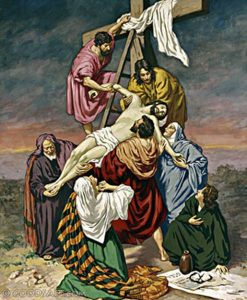The crucifixion and burial of the Lord
The Church commemorates the passions and crucifixion of Jesus Christ (Matthew 27:32-44, Mark. 15:21-32, Luke 23:26-43, John 18:17-27). After the Passover the Roman soldiers led by Judah arrested Jesus in the garden of Gethsemane. The passions of Christ begin from that moment. The Armenian Church has sanctified the commemoration of these events through appropriate services. Jesus Christ was delivered by the hands of the guilty and was sentenced to death. The meaning of Holy Friday is concentrated on the story of crucifixion.
On Good Friday a symbolic tomb of the crucified Jesus Christ is adorned with flowers and thick branches of evergreen trees with the participation of the faithful. It is placed in the church on Friday morning and remains there until Saturday midday of Holy Week. A blessed and consecrated cross wrapped in white linen is put in the wreathed tomb symbolizing our Lord Jesus Christ who was wrapped and laid in the tomb (Matthew 27:59, Mark 15:46, Luke 23:53, John 19:40). Two candles are lit symbolizing the angels.
In the afternoon of Holy Saturday, three hours before the eve of Resurrection the clergymen undo the wreathed tomb and distribute the flowers and branches to the faithful.
The sacrament of the divine truth established by the crucifixion and burial of our Lord Jesus Christ – the Sacrament of Resurrection which is considered to be the pledge of man’s salvation and the basis of Christian faith, is presented to the faithful through this spiritual tradition, through the symbolic tomb of our Lord.
The tomb is considered to be the symbol of death of the human life which fills man’s soul with fear and anxiety. These feelings grow intense especially in the souls of those who are devoid of faith in eternal life. Thus, the symbolic tomb which is used on the commemoration days of the crucifixion and burial of our Lord comes to restrain the fear and the anxiety, the horror and the disbelief in the souls of the people. However, this tomb is not considered to be a grave mound or a stone hill, but a bouquet of flowers and moreover a variegated bouquet of flowers. It doesn’t convey bad news of death and deprivation but tells us the good news of eternity and happiness. Everyone who sees the tomb should be reminded of the prediction of the prophet: “When this perishable body puts on imperishability, and this mortal body puts on immortality, then the saying that is written will be fulfilled: “Death has been swallowed up in victory.” (1 Corinthians, 15:54-55). The presence of the symbolic tomb of our Lord during the Holy Week stands for light, resurrection, life and immortality.
The flowers and the evergreen branches symbolize the feelings of joy, happiness, as well as respect, devotion, faith, hope and love which describe any true Christian.
Through baptism; faith, hope and love which are the beginnings of all the virtues, flourish in the souls of Christians. Thus, it is necessary to be evergreen in good deeds, so that the flower of the garden in our souls will never fade and never lose its sweet smell, so that the living “grave” body of soul won’t become a pit. Like the Lord’s symbolic tomb which is wreathed with the flowers of different colours every Christian must be decorated with various virtuous deeds and charity.
Date/Time
Date(s) - 7th April 2023
6:15 pm - 7:45 pm
Location
St. Yeghiche Armenian Church
Categories No Categories

